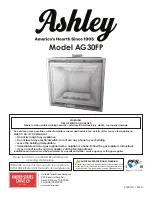
27
NOTE: DIAGRAMS & ILLUSTRATIONS ARE NOT TO SCALE.
Hinge Pin
Gas Valve
Piezo Igniter
Latch for
Glass Door
Figure 49
TEST ALL CONNECTIONS FOR GAS LEAKS
(FACTORY AND FIELD):
Turn on gas supply and test for gas leaks us-
ing a gas leak test solution (also referred to
as bubble leak solution). Note: Using a soapy
water solution (50% dish soap, 50% water)
is an effective leak test solution but it is not
recommended, because the soap residue that
is left on the pipes/fittings can result in corro-
sion over time.
Turn on gas supply and test for gas leaks using
a gas leak test solution.
A. Light the appliance (refer to the lighting
instructions label in control compartment
or the care and operation manual).
B. Brush all joints and connections with the gas
leak test solution to check for leaks. If bubbles
are formed, or gas odor is detected, turn the
gas control knob (off/pilot/on) to the “OFF”
position. Either tighten or refasten the leaking
connection, then retest as described above.
C. When the gas lines are tested and leak free be
sure to rinse off the leak testing solution,
D. Turn on burner then observe the individual
tongues of flame on the burner. Make sure
all ports are open and producing flame evenly
across the burner. If any ports are blocked, or
partially blocked, clean out the ports.
Note:
The gas supply line must be installed in accordance with building codes by a qualified install-
er approved and/or licensed as requed by the locality. In the Commonwealth of Massachusetts,
installation must be performed by a licensed plumber or gas fitter.
Step 6. CONNECTING GAS LINE
Make gas line connections. All codes require a
shut-off valve mounted in the supply line.
Figure
48
illustrates two methods for connecting the
gas supply. The flex-line method is acceptable
in the U.S., however, Canadian requirements
vary depending on locality. Installation must
be in compliance with local codes.
These appliances are equipped with a gas flex
line for use (where permitted) in connecting
the appliance to the gas line. A gas flex line
is provided to aid in attaching the direct vent
appliance to the gas supply. The gas flex line
can only be used where local codes permit. See
Figure 48
for flex line description. The flex line
is rated for both natural gas and propane gas.
A manual shut off valve is also provided with
the flex line.
The incoming gas line should be piped into
the valve compartment and connected (see
Figures 48 & 49
)
. The millivolt control
valve has a 3/8" (10 mm) NPT thread
inlet port. The electronic control valve
has a 1/2" (13 mm) NPT thread inlet port
and is fitted with a 1/2" x 3/8" (13 mm x
10 mm) NPT fitting.
Secure all joints tightly using appropriate
tools and sealing compounds (ensure propane
resistant compounds are used in propane
applications).
Optional: Seal around the gas line to prevent
cold air leakage.
Figure 48 -
GAS CONNECTION
Gas
Valve
3/8" NPT x
Flare Fitting
3/8" Flex Tubing
3/8" Nipple
3/8" union
3/8" Close Nipple
3/8" Shut-off Valve
1/2" x 3/8"
Reducer
Gas
Stub
1/2" x 3/8" Flare
Shut-off Valve
Gas Flex Line Connector
*Sediment Trap
*A Sediment Trap is recom-
mended to prevent moisture
and debris in gas line from
damaging the valve.
3"
Min
.
CONTROL COMPARTMENT ACCESS INSTRUCTIONS (
Ref. Figure 49
)
Opening Control Compartment Door:
Gently depress the outer top corners of the louvered
Control
Compartment Access Panel
until the spring-loaded magnetic catches "pop" it free, allowing it to
swing out and down to open.
Removing Control Compartment Door:
With the panel in the open position, depress the spring-
loaded hinge pin on left side until it disengages from the left cabinet panel hole. Pull panel away
from fireplace.
HI/LO (flame height
control knob)
OFF/PILOT/ON (gas control knob)
Gas Flex Line
Control Compartment
Access panel
OFF/ON Switch
WARNING: Never use an open flame to check for leaks.














































